Boots on the ground: Q&A with 2016 Olympic course superintendent Neil Cleverly

Sun, sand and tourists.
That’s the culture surrounding Neil Cleverly, superintendent of the 2016 Olympic golf course, in his temporary home, Rio de Janeiro, Brazil. Cleverly’s stay in the South American nation is focusing on two things: getting the course ready for the return of golf to the Olympics after a 112-year absence and spreading the goodwill of golf to the people of Brazil.
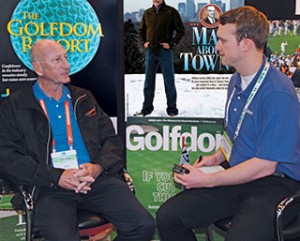
Cleverly sat down with Associate Editor Grant B. Gannon at Golfdom’s booth during the 2015 Golf Industry Show.
Photo: Seth Jones
Both are demanding, but if anyone can handle the tasks it’s Cleverly. The ex-military man exudes poise that comes from experience working on golf courses from the U.S. and Mexico to Europe, Egypt and the Carribean.
We sat down with Cleverly at the 2015 Golf Industry Show in San Antonio and talked about the course, the politics of the region, his staffing challenges and the legacy of the Olympic golf course.
Golfdom: How are preparations going in Brazil?
Cleverly: The weather’s great, but flying from 100 degrees down to 32 at night is no fun.
Plus, there are politics involved; there always will be, no matter the site. It just happens to be the Rio Olympic golf course. Obviously people are interested, and they are entitled to be. Golf not (being) in the Olympics for 100-odd years is a big deal.
Golfdom: The course is made up of zoysia with paspalum greens. How is that combination coming together?
Cleverly: It’s an interesting choice; it’s never mixed before as far as I know. Zoysia Zeon is different physiologically to paspalum. I’ve worked with paspalum for the past 14 years. I’ve done other Zoysia Diamond projects and Emerald projects, but this is a new variety for me.
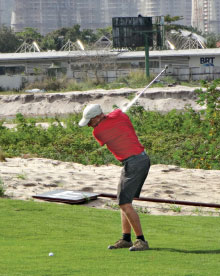 Neil Cleverly hits the first shot on the course — on No. 17. |
Generally zoysia is a good grass, but it’s not the magic bullet grass. Grasses on this planet Earth are designed to be placed in or grown in climates that are conducive to good growing conditions. It happens to be one of the better grasses in that particular area. There’s no question about that, it shows, with very little input.
Golfdom: What kind of chemical program are you using out there?
Cleverly: There’s no excessive use of chemicals. I’m not allowed to use herbicides, so there’s a lot of handpicking of weeds.
There are ways and means of growing grass beyond what you learned in school. You have to experiment sometimes. On this particular project I experimented a lot and I’ve come up with a formula for that. I mix and match some of my own ‘juju juice.’
Another challenge for me is the products that are available locally. It’s not an area for companies to stock and supply what I require for golf maintenance.
Golfdom: When tournament time comes, what kind of course will the players and audience see? A lush and green course or brown, fast and firm?
Cleverly: Eventually we are probably going to go for a block-mow look. We are not going to be overly green but we aren’t going to be overly brown.
At some point someone will encourage me to do what they want to do but it has to be a collective responsibility as to how we are going to present it. No matter what, we will present a golf course that will be worthy of 112 years of missed golf.
Golfdom: What kind of local crew have you hired to work on the course?
Cleverly: The crew that I employ, sometimes they don’t last because they don’t like weed-picking 24/7. The attrition rate is about 30 percent a month, and you have to keep training these guys. The ones who do last look at me like I’m crazy when I arrive at 4 a.m. or 5 a.m. or when I’m doing experimental things.
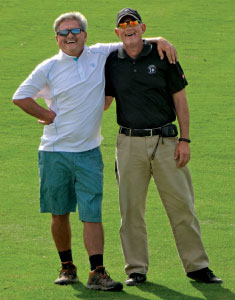
David Doguet, Bladerunner Farms, and Rich Brogan, PGA Golf Course Properties, during grow-in.
Photo courtesy: Marcelo Matte, Green Grass Brazil
I get a kick out of it in the morning when I look at them strolling in, and it’s like a deer in the headlights when I’ve written things on the board but they really don’t know why we are doing it. I’m trying to create a whole new turf school for them in terms of understanding turf and why we do things at certain times of year.
Golfdom: So the whole process is a culture shock for them?
Cleverly: When I told them that we would be sleeping at the course they kind of looked at each other, asking “why?” I had to explain to them that we aren’t mowing at 7 a.m., people are playing at 7 a.m.
It’s a massive culture shock for them, but I’m very humbled by the group I have. Some of my crew travels four hours on a bus to come to work and take the same trip home that evening.
And my key staff — Fabian (Espinola, deputy superintendent), Sofia (Urrets, senior irrigation tech) and Suelen (Santos, administrative assistant) — are vital to the success of the project.
Golfdom: Will there be any upcoming events to prepare the crew for tournament play?
Cleverly: We will have a test event before the Olympics. It will test the golf course and probably my sanity at that point. You really start to stress because I’ve got a bunch of guys and all they’ve done is weed pick or pick grass or shave things with bunker rakes. Now I’ve got to introduce them to the entirely new concept of tournament preparation.
Golfdom: Where on the course do you think the professionals will struggle the most?
Cleverly: We have our “Amen Corner” that starts at Nos. 2, 3, 4 and 5. It circumvents the lake that feeds the irrigation.
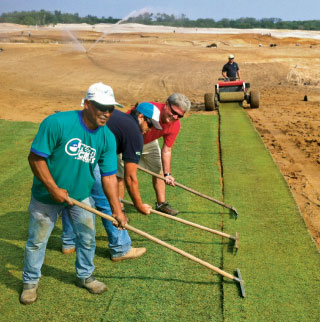 The Zeon Zoysia turf was designed to grow in a climate like Brazil’s and requires minimal input, according to Cleverly. |
On the second hole you have a long tee shot to a skinny landing area. No. 3, you drive across the water, and it’s a teaser hole — that’s a short par 4. So they can drive it, but if they hook it left they’re in the water and if they slice or fade it right they are in the jungle.
I think the pros are going to love it, I really do. You’re never going to please everybody in this business, but these guys are going to love it.
Golfdom: What is the culture of golf in Brazil and how do the locals view the sport?
Cleverly: Brazil has a quiet pedigree of wealthy businessmen who play golf. They don’t have a pedigree of anything like public golf. Some people don’t even think it is a sport in Brazil. That’s the mentality we have to change. I can’t do it on my own.
There are people within Brazil who don’t want the Olympic golf course to be a success and, unfortunately, social media allows them to mobilize quicker than they ever would have done before.
Golfdom: That being said, what do you think the future of golf can be in Brazil? How will the Olympics impact the sport in the country?
Cleverly: That’s what I like when I talk to people. It’s not just about the golf course; it’s what’s going to happen afterward.
Will we get golf tourism beyond this or before this? Yes, but they will come once and they won’t come again.
There has to be repeat business, and your locals are your repeat business. That doesn’t mean it’s a private club, it means that it’s open to the public at a reasonable fee that they can pay, but (they need to) target the kids to encourage a progressive learning curve for the game of golf.
If it is made available in terms of finance, education and equipment, there shouldn’t be any reason why there couldn’t be a Brazilian major champion inside of 25 years. It would take that long because it is a juvenile sport in a very well-known country.
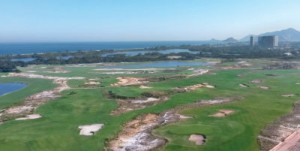
Photo by: Neil Cleverly
Golfdom: Looking into the future, what kind of legacy do you want to leave behind for this course after the Olympics have gone?
Cleverly: It would be a crying shame if the legacy of this golf course gets to the point where the Olympic Games are played on it successfully but (the course) goes to rack and ruin. If that happens, a lot of hard work would be wasted. I think it would be harmful for the country, definitely harmful for golf.
This will be a legacy golf course, which will be handed over to the city of Rio de Janeiro, and we need to promote it that way from this point forward. The only way we can do that is to provide education and equipment to the junior level free of charge. I openly say that, I don’t mince my words.
It needs to be given free and provided free of charge. We are not going to get anywhere, now or in the future, on this golf course or with golf, if we don’t provide that kind of education.
Photos by: Seth Jones









